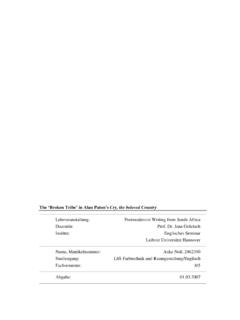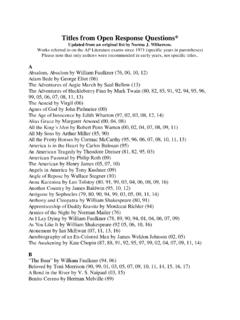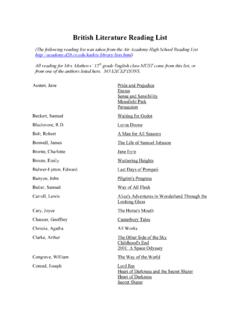Transcription of CRY, THE BELOVED COUNTRY by Alan Paton - …
1 BookWolf Wolfnotes, available at , Copyright 2001-2002, All Rights ReservedDistribution without written consent of is strictly SUMMARY Paton sCRY, THE BELOVED COUNTRYTHE AUTHOR ALAN Paton (1903 1988)James and Eunice Paton , from England, settled in Natal Province, South Africaand they had a son, Alan born to them on 11th January lived in the city of Pietermaritzburg and their eldest child, Alan lived acontented childhood, being both active and intelligent. At the age of twenty-two, Alan commenced a teaching career, firstly teaching at a native school in thevillage of Ixopo. He had graduated from the University of Natal where he had shown promise as a poet, buthe was not satisfied with his early writings and these were mainly destroyed by him. He gave up histeaching career in order to take on the post as Principal at the Diepkloof Reformatory where he attemptedto bring more freedom to the oppressive regime at this institution.
2 He was concerned in ensuring that theboys received a proper education in order to prepare them for life outside the Reformatory walls. Dedicatedto this area of work, he was determined to find out how such institutions operated outside South Africa andhe traveled extensively. Whilst traveling in Scandinavia, the idea behind the book, Cry, The BELOVED COUNTRY was born, and headded to this original thought over several years until the final book was published in 1948. The onset of World War II had curtailed Paton s reforms for the Diepkloof Institution, but after the war, Paton started on an ambitious program to revolutionize prisons and reform schools in South Africa. Cry, The BELOVED COUNTRY became popular throughout the English speaking world, in particular in theUnited States, where similarities were evident to Steinbeck s Grapes of Wrath.
3 The book was also adaptedfor the stage and the motion picture industry, the film being released in 1952. Paton wrote various booksincluding Too Late the Phalarope published in 1953, The Land and the People of South Africa published in1955, Hope for South Africa published in 1959, and Jan Hofmeyr a biography of Paton s friend, the formerDeputy Prime Minister of South Africa published in his life Paton showed concern about the political regime in South Africa and he helped form theLiberal Party and was the Party President for a time. He became more and more outspoken and this led tohim being charged with Treason in 1960, and his Passport was revoked. The Liberal Party was outlawed bythe South African Government, which led to its eventual dissolution in 1968. With others, Paton wasinvolved in the famous Treason Trials alongside Albert Luthule who was the Anglican Bishop ofJohannesburg and Nobel Prize-winner.
4 Although the victims of these Trials were eventually set free fromprison, Paton was not allowed to travel outside of South Africa for many his life, Alan Paton spoke out against the injustices suffered by the Black majority of died at his home near Durban in 1988. The Times Obituary said, His view of his Century becamebleaker: he could foresee only a bloodbath. But his Christian faith sustained him; and although criticized byradical elements, he enjoyed widespread respect as a saintly man who was by no means unworldly. SETTINGP aton s main purpose in his book Cry, the BELOVED COUNTRY is to comment on the social standing of theblack native Africans and the resulting interface with the ruling minority whites. In order to make hisdocumentary memorable, he incorporates a plot and characters so as to give the book a universal some extent the characters and how they develop in the story is secondary to the changes he feels arenecessary in order that South Africa makes the transition from a Dutch/British colony to an independentState in s viewpoint is from the late 1940 s, but to understand how the South Africa of this day evolved, it isnecessary to understand its book is geographically centered on Johannesburg in the Natal Province, which is the homeland of theZulu nation.
5 There were around 4,000,000 Zulus living in an area of 10,500 sq. miles. They were a proudand handsome people and before the Europeans arrived, they were the ruling power in this area of the centuries, they evolved an efficient tribal system. They originally occupied Central Africa andmigrated south to the more fertile areas of COUNTRY . Their homeland was first invaded by the Dutch whoBookWolf Wolfnotes, available at , Copyright 2001-2002, All Rights ReservedDistribution without written consent of is strictly fierce resistance, but ultimately they drew back from the unyielding invaders. The British involvementin the area took place in the 1870 s, and again this resulted in various battles and the British eventuallyoverran their reduced homeland.
6 There was still unrest in the area up until 1907 and the Colonists controlover the Zulus was always Africa was a rich area fought over by the Dutch, British and Germans, and the Portuguese also ruledMozambique to the north-east of the European point of view colonization of this area brought civilization to the Zulus and other tribes. From the Zulu point of view, their position as overlords and masters of their own land had been taken awayfrom them and they have been reduced to a subservient race for the bulk of the 20th Dutch settlers, known as Boers, which means farmers, occupied 2 independent states in the Transvaaland the Orange Free State, and inevitably conflict broke out between them and the British, resulting in theBoer Wars, which started in 1910, all the South African territories were united in the Union of South Africa with a former BoerGeneral, Louis Botha being Prime Minister.
7 South Africa experienced upheavals in the 20th Century up until the time of this book in was a conflict between the Liberal Parties who wished to industrialize South Africa bringing inimmigrants to help with this development and bring about a more integrated society. The Nationalist Partyopposed this. They wanted to virtually ban any immigration and exert total control over the nativepopulation. In the elections of 1948 the Nationalists obtained power with a very narrow majority. Not longafter that they began their program of apartheid, which means apartness or complete segregation of theraces. Citizens were to be segregated into Europeans, the Indian population, the natives and the colored,the latter being a mix of European and native book opens at the remote village of Ndotsheni in the Natal Province of Eastern South Africa.
8 It is central character is the Reverend Stephen Kumalo who has seen his immediate family fragment anddeparts to the city of tries to adhere to the old ways, but the emerging South Africa has brought about the destruction ofthe tribal communities. Kumalo and his wife mourn the disappearance of their family to the city mainlybecause they receive no communication from them. When a letter arrives from Johannesburg, they areapprehensive for they suspect that it brings them bad news. The letter is from the Reverend Msimanguwho runs a Mission House in Johannesburg. The letter advised Kumalo that his sister has fallen on hardtimes and has turned to prostitution. Kumalo resolves to journey to Johannesburg to assist his sister andalso take the opportunity to discover the whereabouts of his son, Absalom and his brother John.
9 They hadboth traveled to Johannesburg to search for the sister Gertrude, but both had not returned and had in the big city is far removed from the rustic societies Kumalo has lived in all his life, and the bustlingmetropolis comes as a shock to him. He is appalled at the enforced segregation and prejudice suffered bythe black people. Although he soon discovers his sister who has a son of her own, his quest to find his ownson is more difficult. His sister wishes to return to the homeland and Kumalo will help her do this. It transpires that the Police are also looking for Absalom who has murdered a white man, Arthur Jarvis, whowas a leading activist pursuing social justice for all. Absalom is found guilty of the crime and is sentencedto s brother, John, has materially benefited from his transfer to the city, but he has turned his back onthe Church and is becomes more and more depressed and the only hope he obtains from his time in Johannesburg isthrough his sister s son, whom he hopes to raise, and his newly acquired pregnant daughter-in-law.
10 Arthur Jarvis father James decides to continue his son s work and right the social injustices suffered by theblacks. Coincidentally, he lives on a farm overlooking the village of Ndotsheni and he decides to help thestruggling natives who live below. He takes measures to limit the effects of famine on the valley and as thebook comes to its conclusion, Kumalo has returned from the city and goes to the mountains to contemplatehis son s impending execution. There he meets with James Jarvis and the two converses regarding the loss of both their see that hope is kindled from the evil that has transpired in the city. Jarvis sees hope in the form of hisyoung grandson, and Kumalo obtains hope through his sister s book ends with Kumalo weeping for his son s death as dawn breaks over Wolfnotes, available at , Copyright 2001-2002, All Rights ReservedDistribution without written consent of is strictly STEPHEN KUMALOHe is the protagonist of the novel, the native priest of the small village of Ndotsheni.





